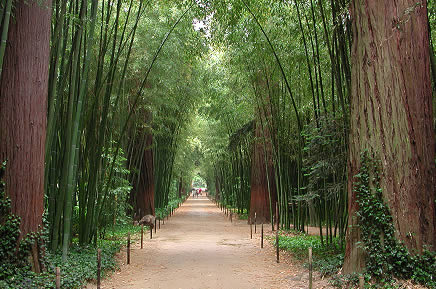

The Languedoc region of France holds many secrets that are only now being discovered. One of these is the wonderful variety of its wild flowers and the wild beauty of their habitat. Add to this a surprising range of gardens and specialist nurseries and you have a whole new world of gardens and botanical sites to explore. Our small group tours are the perfect way to discover this enchanting corner of France.
Hidden Gardens Hidden France’s inclusive tour itineraries vary from the traditional to the exotic, from the formal to the "sauvage". Accompanied by a knowledgable and locally-based horticulturist, visits to gardens and other locations are interspersed with historical venues, wine-tasting and gourmet meals. We aim to give you a taste of something different, to introduce you to a horticulturally undiscovered region of France stretching from the coastal region with its lagoons, to the wide expanses of vineyards on the plain and the wildness of the Montagne Noire.
Your horticulturist, Gill Pound, combines the running of a nursery featuring unusual plants www.lapetitepepiniere.com, with garden consultancy and courses in gardening. She is a specialist in plants for dry climates and experiments with new varieties. Taking care of your accommodation, transport and creature comforts is Liz Thompson, who has extensive experience in event organisation. Liz is also a long-time member of the globally-active Mediterranean Garden Society. Both Liz and Gill have lived for many years in the Languedoc and know the region intimately. They look forward with pleasure to introducing you to this fascinating piece of "la France profonde."
Should you belong to a Garden Club or other interested group, we would be happy to organise a tailor-made tour for you. Please contact us for further information.
A Wild & Magical Place
The Languedoc region of the south of France is at its best in the spring when the countryside bursts forth after the winter rains, and in early autumn when the autumn showers bring the landscape back into life after the heat of the summer. Add to this, wonderful Cathar castles, perched on impossible promontaries watching over the valleys below; dramatic landscapes – river gorges and the garrigue countryside; Roman remains; medieval towns; the Canal du Midi and of course, the vineyards, where recent emphasis on quality rather than quantity has resulted in the production of prize-winning vintages.
The Languedoc region of the south of France is at its best in the spring when the countryside bursts forth after the winter rains, and in early autumn when the autumn showers bring the landscape back into life after the heat of the summer. Add to this, wonderful Cathar castles, perched on impossible promontaries watching over the valleys below; dramatic landscapes – river gorges and the garrigue countryside; Roman remains; medieval towns; the Canal du Midi and of course, the vineyards, where recent emphasis on quality rather than quantity has resulted in the production of prize-winning vintages.
Its main towns owe their origins to the Gauls or the Romans and so have existed in one form or another for over two thousand years. The Cité at Carcassonne is now a UNESCO World Heritage Site. Narbonne, which stood on the Via Domitia, the major Roman road connecting Italy to Spain, is a delightful place to wander and experience the delights of its covered market. Béziers was a Cathar stronghold besieged and overrun by Simon de Montfort, which found new prosperity with the construction of the Canal du Midi in the 17th century, itself also a World Heritage Site. Montpellier is the capital of the Languedoc, boasting one of the oldest universities in the world and the second oldest Botanical Garden in Europe.
In close vicinity are also to be found impressive Cathar castles such as Peyrepertuse and Quéribus and the line of four castles high above the valley at Lastours; the picturesque village of Minerve, yet another seat of Catharism; a number of beautiful abbeys of which Fontfroide is the most spectacular; and closer to the sea, the étangs: salt-water lagoons rich in birdlife, including flamingoes, cormorants, herons and waterfowl.
The Countryside
The Languedoc is one of the hottest areas of France with most of the region falling into the Mediterranean climate zone. However, it is a large region with considerable climate and vegetation changes within it –which makes it all the more fascinating for the visitor interested in botany, plants and gardens. Near the coast, the weather is warmer and sunnier than further inland and it rarely freezes in winter. Inland, summers are hotter and winters are colder until the mountainous parts of the region are reached where the climate changes again.
The Languedoc is one of the hottest areas of France with most of the region falling into the Mediterranean climate zone. However, it is a large region with considerable climate and vegetation changes within it –which makes it all the more fascinating for the visitor interested in botany, plants and gardens. Near the coast, the weather is warmer and sunnier than further inland and it rarely freezes in winter. Inland, summers are hotter and winters are colder until the mountainous parts of the region are reached where the climate changes again.
For the plantsman and gardener the most interesting part of the region is away from the coast, towards the foothills of the mountains. A patchwork of vines, interspersed with the silvery green of olive plantations contrasts with the rugged wildness of the garrigue and maquis countryside with characteristic Mediterranean vegetation, rich and varied: evergreen oaks; junipers; pines; strawberry trees; aromatic plants such as cistus, thyme, lavender and rosemary – plants which can sustain life in this arid, stony soil during the hot, dry summers. During the spring months there is the delight of finding some of the wild bulbs and orchids which are native to the area: charming miniature narcissi, tulips, the many colours of dwarf irises.
The gardens of the Languedoc are quite different from neighbouring Provence. Some of the gardens reflect the nineteenth century period of prosperity in the area, such as the well known and established gardens of the Château de Flaugergues and the Bambouseraie de Prafrance. There are gardens which complement magnificent monuments such as the stunningly beautiful Abbaye de Fontfroide. However, many of Languedoc’s gardens have been established more recently by quirky enthusiasts and “passionnés”: the Jardin de La Bouichère, for example, was begun less than thirty years ago, but is already home to over 2,500 plants on a two hectare site. At the Cactuseraie in Montolieu, Nicolas Rouger is continually experimenting with cacti and succulent plants which will withstand the winters in the area. The prizewinning Jardins de St Adrien owe their existence to one man’s vision of transforming the desolate abandoned quarry, where he played as a child, into a place of beauty. All are gardens which are a delight and an adventure to explore.
Hidden Gardens Hidden France tour includes pick-up at Carcassonne airport or the train stations in Narbonne, Carcassonne and Béziers.
There are international airports at Toulouse and Montpellier serving scheduled flights with major airlines. From here you can take a train to the above towns for pick-up.
If you are coming from the UK or Ireland there are a number of low-cost airlines which fly into the six airports in the region: Carcassonne, Perpignan, Nîmes, Montpellier, Toulouse and Béziers.
Please consult the following websites for more information:
www.ryanair.com
www.flybe.com
www.flybmi.com
www.easyjet.com
www.ryanair.com
www.flybe.com
www.flybmi.com
www.easyjet.com
By train: Eurostar to Paris and then TGV to Narbonne
www.raileurope.co.uk
www.raileurope.co.uk
Or, alternatively, you can take a leisurely drive through France in your own car and extend your Hidden Gardens Hidden France holiday.
Hidden Gardens Hidden France
La Grande Maison
Rue des Caves Hautes
F 34210 Cesseras
France
La Grande Maison
Rue des Caves Hautes
F 34210 Cesseras
France
Tel: 00 33 (0)4 68 91 36 96
e-mail: [email protected]
e-mail: [email protected]


No results found
